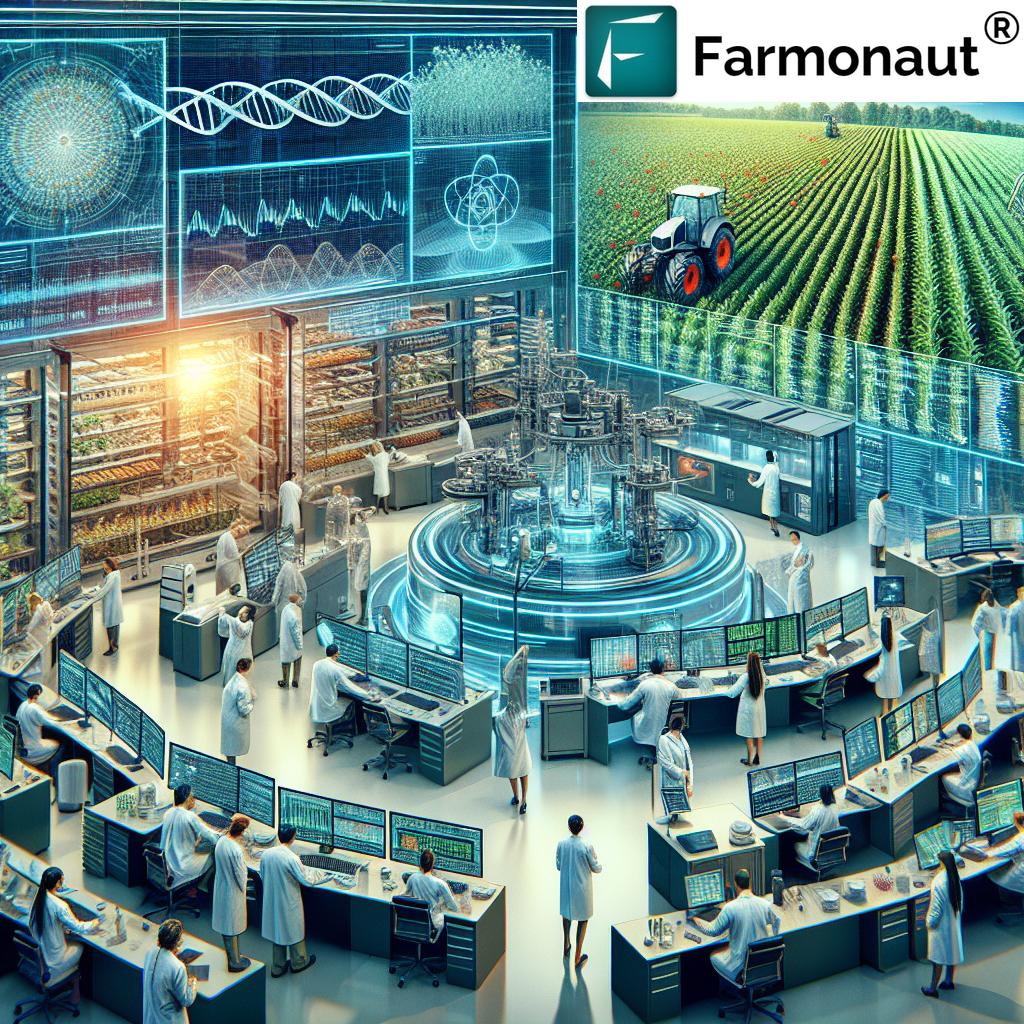Revolutionizing Canadian Agriculture: How Precision Farming and Omics Technology Boost Food Security in Saskatchewan
“OPAL combines 3 cutting-edge fields: genomics, phenomics, and bioinformatics to revolutionize Canadian agriculture.”
In the vast prairies of Saskatchewan, a quiet revolution is taking place that promises to transform Canadian agriculture and bolster food security for generations to come. At the heart of this transformation lies the groundbreaking integrated Omics and Precision Agriculture Laboratory (OPAL), a state-of-the-art facility that combines cutting-edge precision agriculture technology with advanced data analysis to optimize crop yields and drive sustainable food production.
As we delve into the world of precision farming and omics technology, we’ll explore how these innovations are reshaping the agricultural landscape in Canada, particularly in Saskatchewan. We’ll examine the role of OPAL in advancing agricultural research innovation and how it’s helping farmers leverage precision farming techniques to apply resources efficiently, reduce environmental impact, and maximize productivity.

The Rise of Precision Agriculture in Canada
Precision agriculture technology has emerged as a game-changer in the Canadian farming sector. This innovative approach to farming management uses information technology and a wide array of items such as GPS guidance, control systems, sensors, robotics, drones, autonomous vehicles, variable rate technology, GPS-based soil sampling, and automated hardware to optimize field-level management with regard to:
- Crop farming
- Fertilizer application
- Pest control
- Herd management
- Water management
By adopting precision farming techniques, Canadian farmers can now apply inputs more precisely to improve the production output while reducing environmental impacts. This approach not only enhances crop yield optimization but also contributes significantly to sustainable food production.
OPAL: A Pioneer in Agricultural Research Innovation
The integrated Omics and Precision Agriculture Laboratory (OPAL) stands at the forefront of agricultural research innovation in Canada. Located in Saskatchewan, this cutting-edge facility combines advanced technologies and data analysis methods to revolutionize crop research and farming practices.
Key features of OPAL include:
- State-of-the-art equipment for comprehensive plant phenotyping research
- Advanced genetic analyses capabilities
- Cutting-edge aerial imaging technology
- Integration of genomics, phenomics, and bioinformatics
- Modern precision agriculture tools like GPS and UAVs
By leveraging these technologies, OPAL is driving food security innovation and supporting Canada’s biotechnology ecosystem. The facility’s unique approach to agricultural data analysis allows researchers to develop tailored solutions for diverse agricultural challenges, from climate change adaptation to resource optimization.
Precision Farming Techniques: Transforming Canadian Agriculture
Precision farming techniques are at the core of OPAL’s mission to revolutionize Canadian agriculture. These advanced methods allow farmers to apply resources more efficiently, resulting in increased productivity and reduced environmental impact. Let’s explore some of the key precision farming techniques being utilized:
1. GPS-Guided Machinery
Global Positioning System (GPS) technology has become an integral part of modern farming. GPS-guided machinery allows for precise navigation and control of farm equipment, enabling farmers to:
- Reduce overlaps and skips during planting, spraying, and harvesting
- Minimize fuel consumption and equipment wear
- Operate efficiently in low-visibility conditions
2. Variable Rate Technology (VRT)
VRT allows farmers to apply inputs such as fertilizers, pesticides, and seeds at variable rates across a field, based on site-specific conditions. This technology helps:
- Optimize resource use
- Reduce waste and environmental impact
- Improve crop yields by addressing specific needs of different areas within a field
3. Remote Sensing and Aerial Imaging
Unmanned Aerial Vehicles (UAVs) and satellite imagery provide farmers with valuable insights into crop health, soil conditions, and field variability. These technologies enable:
- Early detection of crop stress and diseases
- Precise mapping of field variations
- Informed decision-making for targeted interventions
Discover how Farmonaut’s satellite-based solutions can enhance your precision farming practices

Omics Technologies: Unlocking the Potential of Canadian Crops
The integration of omics technologies at OPAL is revolutionizing our understanding of plant biology and opening new avenues for crop improvement. These technologies include:
1. Genomics
Genomics involves the study of an organism’s complete set of DNA. In agriculture, genomics helps:
- Identify genes responsible for desirable traits
- Develop more resilient and productive crop varieties
- Accelerate breeding programs through marker-assisted selection
2. Phenomics
Phenomics is the study of plant phenotypes – the observable characteristics resulting from the interaction of genes and environment. Advanced phenotyping technologies at OPAL allow researchers to:
- Measure plant traits with high precision and throughput
- Understand how plants respond to different environmental conditions
- Identify optimal plant varieties for specific growing conditions
3. Bioinformatics
Bioinformatics combines biology, computer science, and data analysis to interpret complex biological data. In the context of agriculture, bioinformatics helps:
- Process and analyze large-scale genomic and phenomic data
- Identify patterns and relationships between genetic markers and plant traits
- Develop predictive models for crop performance under various conditions
“Saskatchewan’s OPAL facility integrates at least 5 advanced technologies: GPS, UAVs, genetic analysis, aerial imaging, and plant phenotyping.”
The Impact of OPAL on Canadian Agriculture
The establishment of OPAL has far-reaching implications for Canadian agriculture, particularly in Saskatchewan. Here are some of the key impacts:
1. Enhanced Crop Yield Optimization
By combining precision agriculture technology with omics-based insights, OPAL is helping farmers optimize their crop yields like never before. This includes:
- Developing crop varieties tailored to specific regions and climate conditions
- Providing data-driven recommendations for optimal planting, fertilization, and harvesting strategies
- Enabling early detection and management of crop stresses and diseases
2. Sustainable Food Production
OPAL’s research contributes significantly to sustainable food production in Canada by:
- Reducing the environmental footprint of agriculture through precision resource management
- Developing crop varieties that are more resistant to pests and diseases, reducing the need for chemical inputs
- Optimizing water use efficiency in agriculture
3. Climate Change Adaptation
As climate change poses new challenges to agriculture, OPAL’s research is crucial in developing adaptive strategies:
- Identifying and developing crop varieties that can thrive in changing climate conditions
- Providing insights into how plants respond to various environmental stresses
- Developing predictive models to help farmers prepare for future climate scenarios
Explore Farmonaut’s API for integrating advanced agricultural data into your systems

Precision Agriculture Technologies and Their Benefits
| Technology | Application | Benefits | Estimated Yield Increase |
|---|---|---|---|
| GPS-guided machinery | Precise navigation and control of farm equipment |
– Reduces overlaps and skips – Minimizes fuel consumption – Enables night operations |
5-10% |
| UAV-based imaging | Aerial crop monitoring and field mapping |
– Early detection of crop stress – Precise field variability mapping – Informed decision-making |
7-15% |
| Soil sensors | Real-time soil condition monitoring |
– Optimizes irrigation – Improves nutrient management – Reduces water waste |
10-20% |
| Genomic analysis tools | Crop variety development and trait identification |
– Accelerates breeding programs – Enhances crop resilience – Tailors varieties to specific conditions |
15-25% |
The Role of Farmonaut in Advancing Precision Agriculture
As we explore the advancements in precision agriculture and omics technology in Canada, it’s worth highlighting the role of innovative companies like Farmonaut in this space. Farmonaut offers advanced, satellite-based farm management solutions that complement the work being done at facilities like OPAL.
Satellite-Based Crop Health Monitoring
Farmonaut’s satellite imagery technology provides farmers with valuable insights into crop health, including:
- Vegetation health indices (NDVI)
- Soil moisture levels
- Early detection of crop stress and diseases
This data helps farmers make informed decisions about irrigation, fertilizer usage, and pest management, aligning perfectly with the precision agriculture principles employed at OPAL.
AI-Driven Advisory Systems
Farmonaut’s Jeevn AI advisory system delivers personalized farm management recommendations based on real-time data analysis. This technology complements the research conducted at OPAL by:
- Providing farmers with actionable insights based on the latest agricultural research
- Offering customized crop management strategies tailored to specific farm conditions
- Helping farmers implement precision farming techniques effectively
Access Farmonaut’s API Developer Docs for detailed integration guidelines
Challenges and Future Directions
While the advancements in precision agriculture and omics technology are promising, there are still challenges to overcome and exciting future directions to explore:
Challenges
- Data Management: The vast amount of data generated by precision agriculture technologies and omics research requires sophisticated data management and analysis tools.
- Technology Adoption: Ensuring widespread adoption of these technologies among farmers, especially small-scale operations, remains a challenge.
- Integration of Technologies: Seamlessly integrating various precision agriculture tools and omics-based insights into practical farming applications is an ongoing process.
Future Directions
- Artificial Intelligence in Agriculture: Further development of AI and machine learning algorithms to provide even more accurate and personalized farming recommendations.
- Gene Editing Technologies: Exploring the potential of CRISPR and other gene editing tools to develop crop varieties with enhanced traits more rapidly.
- Robotics and Automation: Advancing the development of autonomous farming equipment to further optimize farm operations.
- Climate-Resilient Agriculture: Focusing research on developing crops and farming practices that can thrive in the face of climate change.
Download Farmonaut’s Android App for on-the-go farm management

Conclusion: A Bright Future for Canadian Agriculture
The integration of precision agriculture technology and omics research at facilities like OPAL is ushering in a new era of sustainable food production and enhanced food security in Canada. By leveraging advanced technologies and data-driven insights, Canadian farmers are better equipped than ever to face the challenges of modern agriculture, from climate change to resource limitations.
As we look to the future, the continued collaboration between research institutions, technology providers like Farmonaut, and farmers will be crucial in realizing the full potential of these innovations. With ongoing advancements in precision farming techniques and omics technology, Canadian agriculture is well-positioned to lead the way in sustainable, efficient, and productive farming practices, ensuring food security for generations to come.
The revolution in Canadian agriculture, spearheaded by facilities like OPAL in Saskatchewan, is not just about increasing yields or reducing costs. It’s about creating a more sustainable, resilient, and productive agricultural sector that can meet the challenges of the 21st century and beyond. As we continue to innovate and adapt, the future of farming in Canada looks brighter than ever.
Get Farmonaut’s iOS App for precision farming on your iPhone

FAQs
- What is OPAL and where is it located?
OPAL (Omics and Precision Agriculture Laboratory) is a cutting-edge agricultural research facility located in Saskatchewan, Canada. It combines advanced technologies in genomics, phenomics, and bioinformatics with precision agriculture tools to revolutionize farming practices. - How does precision agriculture contribute to sustainable food production?
Precision agriculture contributes to sustainability by optimizing resource use (water, fertilizers, pesticides), reducing waste, minimizing environmental impact, and improving crop yields through targeted, data-driven farming practices. - What are some examples of precision farming techniques?
Examples include GPS-guided machinery, variable rate technology for input application, remote sensing and aerial imaging for crop monitoring, and soil sensors for real-time condition monitoring. - How does omics technology benefit agriculture?
Omics technologies (genomics, phenomics, bioinformatics) help in developing more resilient and productive crop varieties, understanding plant responses to environmental conditions, and accelerating breeding programs through advanced data analysis. - What role does Farmonaut play in precision agriculture?
Farmonaut provides satellite-based farm management solutions, offering services like crop health monitoring, AI-driven advisory systems, and resource management tools that complement and enhance precision farming practices.



